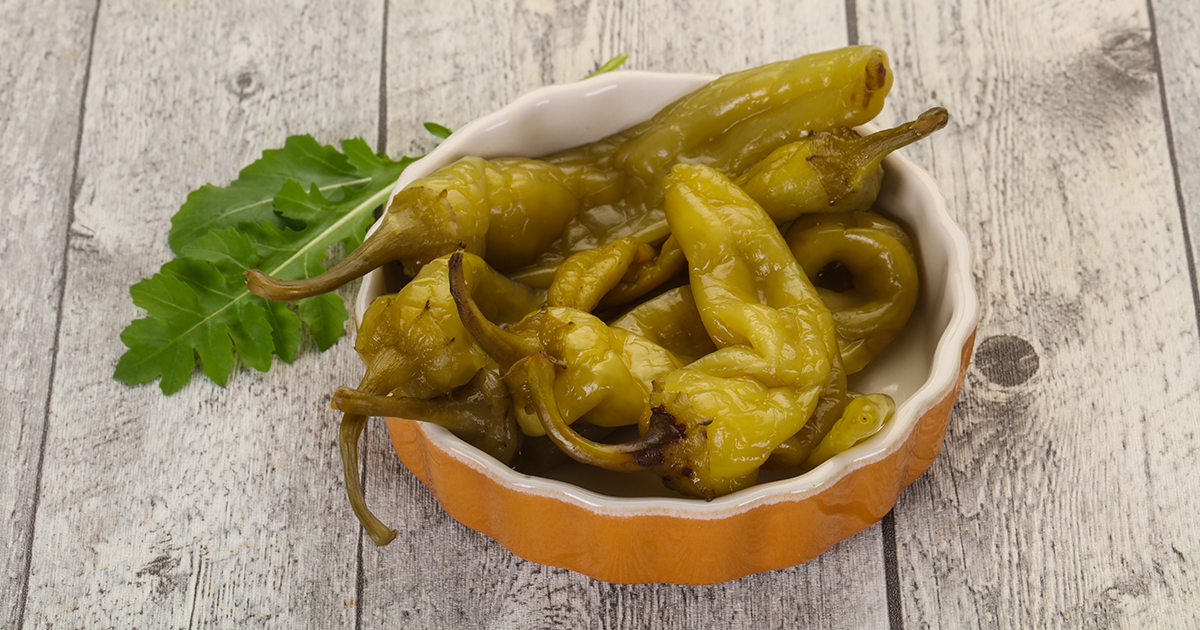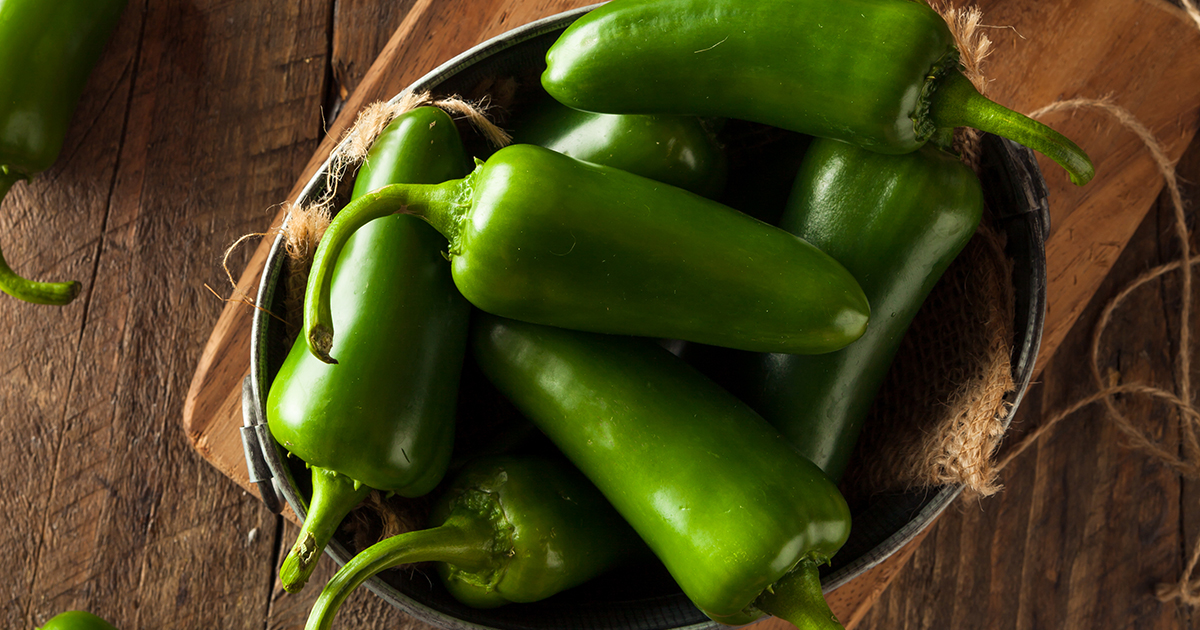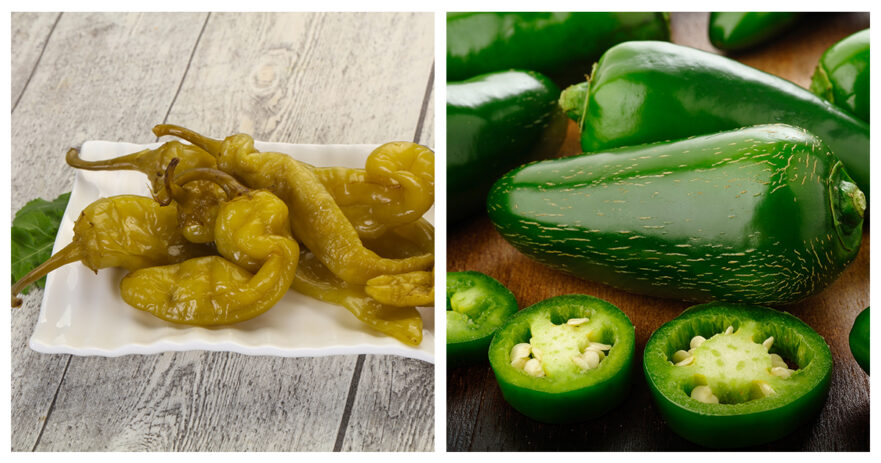From mild and sweet to fiery and spicy, peppers play an important role in many cuisines worldwide. If you like adding a touch of heat to your dishes, then chances are you will already be familiar with pepperoncini and jalapeño peppers.
However, while they may look similar, they have distinctive differences. That is why we thought we would explore the key characteristics of these two delicious and spicy peppers!
| Pepperoncini pepper | Jalapeño pepper | |
| SHU | 100 - 500 | 2,500 - 8,000 |
| Median SHU | 300 | 5,250 |
| Flavor | Mildly sweet and tangy, with a slight heat | Grassy, vegetale, slightly sweet, and moderately spicy |
| Species | Capsicum annuum | Capsicum annuum |
| Origin | Italy | Mexico |
| Uses | Pickling, salads, sandwiches, antipasto, etc. | Salsas, guacamole, nachos, jalapeño poppers, etc. |
Table of contents
What is Pepperoncini?

Pepperoncini, also known as Tuscan pepper, is a small and sweet chili pepper that offers a mild heat level. Used widely across Mediterranean cuisine, if you have ever eaten a Greek salad or an Italian antipasto platter before, there is a good chance you have encountered a pepperoncino before.
Pepperoncini peppers typically range from 100 to 500 Scoville units, which is considered a mild heat level. This makes them a great choice for those who prefer a subtle kick of heat in their food without having it overpower other flavors.
In Italy, their country of origin, pepperoncinis are often used in pasta sauces, pizzas, and salads, while in Greece, they are served as a meze, a small dish that accompanies alcoholic drinks. Of course, they are not just used in the Mediterranean; these peppers are also found in Tex-Mex cuisine and are a favorite topping for hot dogs and hamburgers in the United States.
For those who adore a bit of bite but don’t yearn for too much heat, pepperoncini peppers are the perfect choice for pickling. Not only do these delightful vegetables offer a mild yet delectable tangy flavor, but they can be infused into an array of dishes – from sandwiches and salads to burgers and pizzas! The vinegar used in the pickling process also provides a fantastic condiment or is added to dressings for extra zing. For more formal events, you may even serve them as part of your side dish or appetizer platter alongside other equally tantalizingly-pickled veggie delights such as cucumbers, carrots, and onions.
Beyond pickling, dried pepperoncini are an incredibly versatile ingredient that can be ground into a spicy seasoning for soups, stews, and chili. Not only are they great on meats, vegetables, and pasta dishes, but they also act as the ideal substitute for crushed red pepper flakes in Italian or Cajun seasonings. To give your recipes a boost of freshness, you could rehydrate the peppers bringing them back to life with a softer texture!
What is a Jalapeño?

A jalapeño is a medium-sized chili pepper that originated in Mexico and is now a staple ingredient in cuisines across the globe. Part of the Capsicum annuum family, which also includes bell peppers and cayenne peppers. Jalapeños are typically 2-4 inches long and vary in color from dark green to red when fully ripe. They have a distinctive flavor that is both spicy and slightly sweet, with a heat level that registers between 2,500-8,000 on the Scoville scale, meaning they are significantly hotter than pepperoncini!
Jalapeños are incredibly versatile and can be used fresh, pickled, or smoked. They are a popular ingredient in Mexican dishes such as salsa, guacamole, and nachos, as well as in other dishes like burgers, pizza, and stews. They can also be stuffed with cheese or meat and then baked, grilled, or fried to make delicious appetizers.
Jalapeños are known for their spicy flavor, but the heat level can vary depending on the pepper’s maturity and growing conditions. The heat is concentrated in the seeds and ribs, so if you remove these, then the heat level will reduce.
If you are looking to add some spice to your dish without making it too hot, then you should consider using a milder chili pepper, like pepperoncini or banana pepper. However, if you’re a fan of spicy food, then jalapeños are a great choice for adding flavor and heat!
How are Pepperoncini and Jalapeño peppers similar?
Despite their flavor and heat differences, pepperoncini and Jalapeño peppers do share some similarities. Firstly, they both belong to the Capsicum annuum species, which includes other popular peppers, including bell peppers, cayenne peppers, and paprika. This means that visually they share a similar shape and texture, featuring thin walls and a fleshy interior.
In terms of appearance, they both vary in color depending on their ripeness. For example, Pepperoncini peppers start off with a bright green color before turning yellow, orange, or red. In contrast, jalapeños typically start off as green and then turn red as they ripen.
Both peppers are also extensively used in dishes around the world to add a bit of heat and flavor. They are also commonly used in pickling, are popular toppings for pizzas and sandwiches, and are extensively used in Mexican and Mediterranean cuisines.
These peppers can be used in a variety of forms, including fresh, pickled, dried, and powdered, making them suitable for a wide range of dishes. For example, when making salsa, hot sauce, and chili or being added to dishes like nachos, quesadillas, and chili con carne. They can also be roasted or grilled to bring out their natural sweetness and smoky flavor.
What are the differences between Pepperoncini and Jalapeño peppers?
Although there are similarities, Pepperoncini, and jalapeño peppers do differ. Pepperoncini peppers have mild and medium heat level, which ranges from 100 to 500 on the Scoville scale. Jalapeño peppers, on the other hand, have a medium to hot heat level that ranges from 2,500 to 8,000 Scoville units, making them significantly spicier.
In terms of their flavor, pepperoncini and jalapeño peppers both have a slightly sweet, tangy taste, but jalapeños are generally spicier and a bit grassy. This difference in heat impacts how they are used in cooking, with jalapeños often used to add spice and pepperoncini for their mild flavor and pickling properties.
The heat level and flavor profile make them suited to different culinary uses, too. Jalapeño peppers are commonly used in Mexican cuisines, such as salsas, guacamole, and other spicy dishes.
Pepperoncini peppers, however, are often used in Mediterranean cooking, such as in pickled vegetable platters and in sandwiches.
Pepperoncini and jalapeño peppers are also distinguishable in terms of size and shape. Pepperoncinis are usually smaller and thinner, measuring up to three inches in length and one inch in diameter.
Jalapeño peppers grow bigger, up to four inches in length, and about 1-1.5 inches in diameter; they are often thicker and plumper, too.
FAQ about Pepperoncini and Jalapeño peppers
How do pepperoncini and jalapeño peppers differ in terms of heat?
Pepperoncini peppers are a mild to medium heat level of up to 500 Scoville units. Jalapeño peppers have a hotter heat level that registers between 2,500-8,000.
What are some culinary uses of pepperoncini peppers?
Pepperoncini peppers are very versatile and used extensively in Mediterranean cuisine, especially in pasta sauces, pizzas, and salads. They are also commonly served as a meze in Greece, while in the States, they are a popular topping for hot dogs and or, when pickled, as a condiment for sandwiches and salads.
What are some culinary uses of jalapeño peppers?
Jalapeños are also versatile and can be used either fresh, pickled, or smoked. A very popular ingredient in Mexican dishes, especially salsa, guacamole, and nachos, they can also be found in everything from burgers and pizzas to stews. Alternatively, they can be stuffed with cheese or meat before being baked, grilled, or fried.
Do pepperoncini and jalapeño peppers share any similarities?
Both pepperoncini and jalapeño peppers are part of the Capsicum annuum species, which includes other popular chili peppers such as bell peppers, cayenne peppers, and paprika. Because of this, they share a similar shape and texture and feature thin skin and a fleshy interior. They are also widely used in various dishes to add a bit of heat and flavor and can be used either fresh, pickled, dried, or powdered.
How do pepperoncini and jalapeño peppers differ in appearance?
Pepperoncini peppers are typically smaller and start out bright green, eventually maturing to a yellow, orange, or red color with thin, more wrinkled skin. In contrast, jalapeños are larger and thicker with smooth, shiny skin that is also green when unripe but turns red when fully mature.
What are the flavor profile characteristics of pepperoncini peppers?
Pepperoncini peppers have a mild and slightly sweet taste, with a lower heat level than jalapeño peppers. The flavor may also include fruity notes, which depend on the variety being used.
What is the flavor profile of jalapeño peppers?
Jalapeños have a distinctive spicy and sweet, grassy flavor, with heat levels ranging from moderate to hot.
